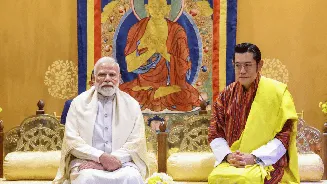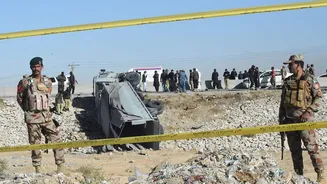Strategically located but landlocked, Bhutan is bordered by both India and China, with the latter regularly negotiating land concessions from the tiny kingdom. India has traditionally been a non-predatory
support to the kingdom, with regular concessionary loans, electricity purchases, and a defence protection pact. India and Bhutan also share long-standing cultural ties, and at present, India has loaned Bhutan some sacred Piprahwa relics of Lord Buddha for a 10-day period during a special Peace Prayer.
Bhutan has always favoured its autonomy and unique ways, including its emphasis on the world-famous concept of Gross National Happiness.
In this current two-day visit, not postponed despite a terror attack in New Delhi’s Red Fort area by JeM and ADuG-inspired operatives, Prime Minister Narendra Modi of India and King Jigme Khesar Wangchuk, the fifth Druk Gyalpo, jointly inaugurated the 1,020 MW Punatsangchhu-II hydroelectric project. The occasion also marked the King’s 70th birthday.
The project’s inauguration was hailed as a milestone in the vibrant and growing, mutually beneficial partnership between India and Bhutan. India also announced a new concessional line of credit of ₹4,000 crore for Bhutan to fund other energy projects.
Bhutan currently produces all its electricity from renewable energy and has a negative carbon footprint. This latest hydroelectric project will increase electricity production from hydro sources by 40%. India will also assist in the resumption of work on the main dam structure of the 1,200 MW Punatsangchhu project.
To promote connectivity for Bhutan and give it easier access to India’s vast markets, a new initiative is about to unfold. The Bhutanese border towns of Gelephu and Samtse will soon be connected with India’s vast railway network. Bhutan also intends to develop the Gelephu Mindfulness City as a consequence. India will establish an immigration check post at Hatisar, just across from Gelephu, and develop infrastructure on its side of the border.
The two countries signed three MoUs during this visit of 11–12 November 2025 — on renewable energy, mental health services, and healthcare.
India had earlier also announced a contribution of ₹10,000 crore in 2024 towards Bhutan’s Five-Year Plan for development in areas such as roads, agriculture, finance, and healthcare.
The railway connectivity with buffer state Bhutan will also help strengthen infrastructure to protect the so-called Chicken Neck and the Siliguri Corridor — both under Chinese scrutiny from the Doklam plateau. India has already strengthened its military presence in the area of the Chicken Neck, including the revival of a WWII-era airport, the placement of troops, missiles, fighter aircraft, and other assets. It has also been conducting elaborate military exercises in all its border regions to ensure preparedness and smooth coordination among the different arms of the military.
This is important because, in addition to China, Bangladesh and Pakistan have also been taking renewed interest in the Chicken Neck and Siliguri Corridor area — vital for India’s communication and connectivity with its northeastern states.
Bhutan is not very comfortable with China’s attention and blandishments regarding development and trade, because as a hereditary kingdom, it is wary of the powerful communist dictatorship. However, there are some in its population and political class who favour closer ties with China. Bhutan, therefore, has to perform a careful balancing act between India and China.
Matters have improved somewhat because of China’s rivalry with the US and the weakening of its economy. It is preoccupied with its own troubles and less interested in adventurism abroad. Much of the billions it has spent on its Belt and Road Initiative and its “String of Pearls” strategy has gone bad.
India, on its part, has identified two chicken neck–like areas in Bangladesh with access to the Bay of Bengal in both cases, which makes it vulnerable to outside attack and capture. This could restrain its ability to seek any misadventure against India. India also controls much of the water that flows into Bangladesh and could cancel its water-sharing arrangements, as it has with Pakistan. Likewise, Bangladesh depends on India for electricity to a large extent. A misadventure could nevertheless happen, driven by jingoism or miscalculation, egged on by Pakistan and China. However, neither country may, in the end, get directly involved, nor will any other Islamic country Bangladesh might count on, such as Türkiye. Myanmar is also going through a troubled relationship with Bangladesh. So, if a military misadventure goes wrong for it, Bangladesh could face territorial trifurcation.
The fact that India is rapidly improving its defences and Aatmanirbhar defence preparedness is important. Its highly successful demonstration in the short Operation Sindoor — against the combination of Pakistan assisted by China — was most telling. Nobody in the neighbourhood, including a China that prefers to use proxies in conflicts, is left sure of itself in any future conflict with India.
India’s exports of armaments and the demand for them have risen sharply since Operation Sindoor. Meanwhile, new systems are being added that extend India’s range, speed, surveillance, and technological capabilities. The possibility of an Operation Sindoor 2.0, in kinetic mode, is hovering in the air and could inflict substantially more damage on Pakistan than the earlier one. The Taliban in Afghanistan are already at war with Pakistan but have mended fences with India.
All this is also not lost on tiny Bhutan as it weighs its options.
The writer is a Delhi-based political commentator. Views expressed in the above piece are personal and solely those of the author. They do not necessarily reflect News18’s views.














